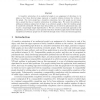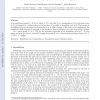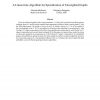COMBINATORICA
1998
13 years 11 months ago
1998
For an undirected graph G = (V, E), let Gn denote the graph whose vertex set is V n in which two distinct vertices (u1, u2, . . . , un) and (v1, v2, . . . , vn) are adjacent iff ...
JGAA
2006
13 years 11 months ago
2006
We consider the problem of constructing a minimal cycle-breaking set of turns for a given undirected graph. This problem is important for deadlock-free wormhole routing in compute...
ENDM
2006
13 years 12 months ago
2006
We introduce the incidence game chromatic number which unifies the ideas of game chromatic number and incidence coloring number of an undirected graph. For kdegenerate graphs with...
DM
2008
13 years 12 months ago
2008
In this paper we present an algorithm to generate all minimal 3-vertex connected spanning subgraphs of an undirected graph with n vertices and m edges in incremental polynomial tim...
EOR
2010
13 years 12 months ago
2010
Given an undirected graph G = (V, E) with a set V of vertices and a set E of edges, the graph coloring problem consists of partitioning all vertices into k independent sets and th...
DAM
2008
13 years 12 months ago
2008
A transitive orientation of an undirected graph is an assignment of directions to its edges so that these directed edges represent a transitive relation between the vertices of th...
CORR
2010
Springer
13 years 12 months ago
2010
Springer
In an undirected graph G = (V, E), a subset C V such that C is a dominating set of G, and each vertex in V is dominated by a distinct subset of vertices from C, is called an iden...
CORR
2010
Springer
13 years 12 months ago
2010
Springer
Given an undirected graph G and an error parameter > 0, the graph sparsification problem requires sampling edges in G and giving the sampled edges appropriate weights to obtai...
CORR
2010
Springer
13 years 12 months ago
2010
Springer
Let G = (V, E) be any undirected graph on V vertices and E edges. A path P between any two vertices u, v V is said to be t-approximate shortest path if its length is at most t tim...
ALGORITHMICA
2010
13 years 12 months ago
2010
Abstract. This paper presents algorithms whose input is an undirected graph, and whose output is a tree decomposition of width that approximates the optimal, the treewidth of that ...








